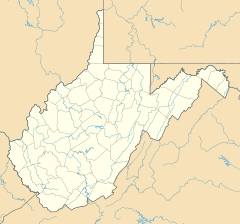Hemphill, West Virginia facts for kids
Quick facts for kids
Hemphill
|
|
|---|---|
| Country | United States |
| State | West Virginia |
| County | McDowell |
| Time zone | UTC-5 (Eastern (EST)) |
| • Summer (DST) | UTC-4 (EDT) |
| GNIS feature ID | 1540139 |
Hemphill is a small, unincorporated community located in McDowell County, West Virginia, United States. It sits along the Tug Fork River, nestled between the communities of Capels and Welch. Being "unincorporated" means it's not officially a city or town with its own local government. Instead, it's part of the larger county.
Contents
What is Hemphill Like?
Hemphill is a quiet place in the beautiful Appalachian Mountains. It's known for its natural surroundings and its history tied to the coal mining industry. Many communities in this part of West Virginia grew because of coal.
Where is Hemphill Located?
Hemphill is in the southern part of West Virginia. It's in McDowell County, which is a county with a rich history. The community is right on the Tug Fork River, which is a branch of the Big Sandy River. This river forms part of the border between West Virginia and Kentucky.
How Does Hemphill Connect to Nearby Towns?
Hemphill is situated along a main road that links it to other communities. To the north, you'll find Welch, which is the county seat of McDowell County. To the south, there's Capels. These connections were important for transporting coal and for people to travel between communities.
A Look at Hemphill's History
Like many places in West Virginia, Hemphill's story is closely linked to the coal industry. In the late 1800s and early 1900s, coal mining became a huge business in this region. This led to the creation of many small communities.
How Did Coal Mining Shape Hemphill?
Coal companies often built entire towns for their workers. These were called "coal camps" or "company towns." While we don't have specific details about Hemphill's founding, it likely grew as miners and their families moved to the area. They came to work in the nearby coal mines.
What Was Life Like in a Coal Community?
Life in a coal community was often challenging but also very close-knit. Families lived near each other, and many people worked for the same coal company. The community often had a company store where people could buy supplies. Schools and churches were also important parts of these towns.
The Tug Fork River and Its Importance
The Tug Fork River is a significant natural feature near Hemphill. Rivers were vital for early transportation and industry.
Why is the Tug Fork River Important?
Historically, rivers like the Tug Fork were used to transport goods. They also provided water for homes and industries. The river's path helped shape where communities like Hemphill were built. Today, it's a part of the natural landscape.
What Wildlife Can Be Found Near the River?
The areas around the Tug Fork River are home to various types of wildlife. You might see different kinds of fish in the river. The surrounding forests provide habitats for deer, squirrels, and many bird species. Nature is a big part of life in this region.
Hemphill Today
Today, Hemphill remains a small, quiet community. While coal mining is not as dominant as it once was, the history of the industry is still a big part of the region's identity.
What is an Unincorporated Community?
An unincorporated community, like Hemphill, doesn't have its own city government. This means there's no mayor or city council just for Hemphill. Instead, services like roads and law enforcement are managed by the larger McDowell County government.
How Do People Live in Unincorporated Areas?
People living in unincorporated areas often rely on county services. They might travel to nearby towns like Welch for shopping, schools, or other services. These communities often have a strong sense of local identity, even without a formal city structure.



